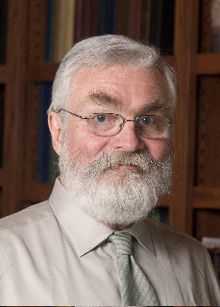Robert M. Gray
| Robert M. Gray | |
|---|---|
 Robert M. Gray (2008) | |
| Born |
November 1, 1943 San Diego, California |
| Nationality | American |
| Fields | Electrical engineering |
| Institutions | Stanford University |
| Alma mater | University of Southern California |
| Doctoral advisor |
Robert A. Scholtz Irwin M. Jacobs |
| Doctoral students |
Michelle Effros David Neuhoff Eve Riskin |
Robert M. Gray (born November 1, 1943[1]) is an American information theorist, and the Alcatel-Lucent Professor of Electrical Engineering at Stanford University in Palo Alto, California. He is best known for his contributions to quantization and compression, particularly the development of vector quantization.
Awards
Gray received the 2008 Claude E. Shannon Award from the IEEE Information Theory Society, for his fundamental contributions to information theory, particularly in the area of quantization theory.[2] He was also the recipient of the 2008 IEEE Jack S. Kilby Signal Processing Medal,[3][4] the 1998 Golden Jubilee Award for Technological Innovation from the IEEE Information Theory Society,[5] and the 1993 IEEE Signal Processing Society Award.[6]
Gray received the 2002 Presidential Award for Excellence in Science, Mathematics and Engineering Mentoring. This award reflects the impact he has had on engineering theory and practice through his students; he has advised 50 Ph.D. students, including 13 women Ph.D.'s.
Amongst other honors, he was elected to the National Academy of Engineering in 2007, and received the IEEE Third Millennium Medal in 2000.
Early life
Born in 1943 in San Diego, Gray grew up in Coronado, California. He was a middle child in a family of five.
Gray followed his two older brothers to the Massachusetts Institute of Technology. He earned the B.S. and M.S. in Electrical Engineering from MIT in 1966, where he was a classmate of Lawrence Rabiner. Gray earned the Ph.D. in Electrical Engineering from University of Southern California in 1969; his Ph.D. advisor was Robert A. Scholtz. During his graduate school years, he played guitar in the rock band (unprintable).
He began his career at the US Naval Ordnance Laboratory, following a family naval tradition.
Books
Gray has written or co-authored a number of technical texts, including:
- Toeplitz and Circulant Matrices (1971, revised 2006)
- Probability, Random Processes and Ergodic Properties (1988, revised 2007)
- Introduction to Statistical Signal Processing (1986, revised 2007)
- Entropy and Information Theory (1991, revised 2007)
- Source Coding Theory (1990)
- Vector Quantization and Signal Compression (1992)
Gray is also an amateur historian and has collected together some historical letters from diplomats into books:
- Amy Heard: Letters from the Gilded Age (2005)
- Max&Max (2005)
Notable professional service
Gray is currently Editor-in-Chief of Foundations and Trends in Signal Processing. He has also been Editor-in-Chief of the IEEE Trans. on Information Theory (1981–1983), and served on the IEEE Information Theory Society Board of Governors (1974–1980, 1984–1987) and IEEE Signal Processing Society Board of Governors (1999–2001).
References
- ↑ Gray, Robert M. "Short Bio". Retrieved 5 March 2013.
- ↑ "Claude E. Shannon Award". IEEE Information Theory Society. Retrieved February 28, 2011.
- ↑ "IEEE Jack S. Kilby Signal Processing Medal Recipients". IEEE. Retrieved February 28, 2011.
- ↑ "IEEE Jack S. Kilby Signal Processing Medal Recipients - 2008 - Robert M. Gray". IEEE. Retrieved February 28, 2011.
- ↑ "Golden Jubilee Awards for Technological Innovation". IEEE Information Theory Society. Retrieved July 14, 2011.
- ↑ "Society Award". IEEE Signal Processing Society. Retrieved February 28, 2011.
External links
- Gray's webpage
- IEEE History Center Interview with Gray (1998)
- Robert M. Gray at the Mathematics Genealogy Project
|